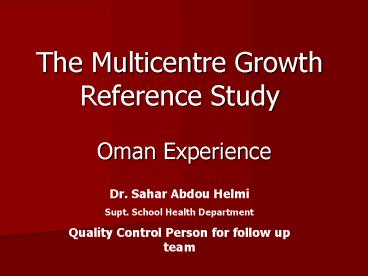The Multicentre Growth Reference Study
1 / 25
Title:
The Multicentre Growth Reference Study
Description:
Muscat population is relatively affluent and educated ... Bimonthly standardization sessions for anthropometry. Terminal digit preferences analysis. ... – PowerPoint PPT presentation
Number of Views:42
Avg rating:3.0/5.0
Title: The Multicentre Growth Reference Study
1
The Multicentre Growth Reference Study
- Oman Experience
Dr. Sahar Abdou Helmi Supt. School Health
Department Quality Control Person for follow up
team
2
Population 2331391 27 in Muscat Muscat
population is relatively affluent and educated
Has ready access to highly developed health
services 96 of births in Muscat take place in
two hospitals
3
RAPID SURVEY (1998)
- Identify socioeconomic , demographic and
behavioral characteristics of the subpopulation
of Muscat region. - The mothers of 336 children aged 28 to 43 months
were selected from the national child health
register and interviewed - Children weights and heights, the maternal
measurements and families SES
4
RESULTS
- Specific socioeconomic status indicators cutoff
of families whose children experience
unconstrained growth in early childhood - Monthly income 800 RO (2,083 )
- At least 4 years of maternal education
- 39 of families usually traveled out of Muscat on
vacation
5
MGRS
- Longitudinal study
- 12 months study
- Cross sectional study
- Motor development study
6
- PLANNING PHASE
- IMPLEMENTATION PHASE
7
STUDY TIMELINE
8
Study Structure in Oman
9
TRAINIG STANDARIZATION
- Longitudinal screening and follow up teams were
trained on anthropometric measurements - Lactation team was trained by an International
Board Certified Lactation Consultant. - All teams were trained to administer the oral
interviews and complete the questionnaire
10
- Six members of Follow up team were trained on
motor development - The secretaries were trained to coordinated the
day to day activities and maintain study
registers and participation flux charts - Two men were trained to measure adult weight and
height
11
STUDY MATERIALS
- MGRS Manual of Operations was adapted
- All questionnaires were translated into Arabic
- An interviewer guides were also translated into
arabic
12
SITE SPECIFIC VARIABLES FOR OMAN
- Screening
- Reasons for not breastfeeding included No reason
given Not enough milk, - SES of household based on mother completed 4
years of formal education - Total income of the household was 800 O.R. or
more.
13
- Follow-up
- Sources of income included social support,
retirement, income from rented property (house,
farm, etc), private business. - Adaptation of the lists of supplements for the
mother, infant formula supplements
14
IMPLEMENTATION PHASE
15
Screening
- Screening was done twice daily, Saturday ?
Wednesday in each hospital - Inclusion criteria are
- Health status of the infant,
- Intention to breastfeed
- Singular births,
- SES of the family
- Willingness to participate.
16
Lactation support
- The lactation counselors visited the enrolled
mothers within 24 hours - MGRS In Oman adopted the complementary feeding
guidelines developed by the MOH.
17
Follow-up
- Each child was visited 20 times till 2 years of
age. - Main data collected
- Morbidity , Feeding pattern, supplements
- Maternal and child anthropometric measurements
18
MULTICENTRE GROWTH REFERENCE STUDY SCHEDULE OF
VISITS
19
Quality control procedures
- Daily review of questionnaires for completion
and accuracy of coding. - Repeat interviews phone calls for 10 of the
mothers. - Data entry by two persons independently.
- Frequency analysis and cross-tabulations for
identification of conflicting responses.
20
- Bimonthly standardization sessions for
anthropometry. - Terminal digit preferences analysis.
- Flux charts and records of different supervisors.
- Regular meetings of different teams, and the
steering committee.
21
CROSS SECTIOANL STUDY
22
SAMPLING STRATEGY
- Child Health Register
- Master list of 24,000 children 18 71 months
drawn from 12 registers - A random sample of 8,000 were selected for
screening to get 1400 children to be measured
23
SUCCESS FACTORS
- Media coverage
- Public relation activities
- Health education materials
- Priority in Health institution
- Two receptions
- Discount cards to shops and restaurants
- All measurements are taken according to the
procedure, and on the scheduled times.
24
- Spirit of team work
- Technical support from WHO
25
THANK YOU































